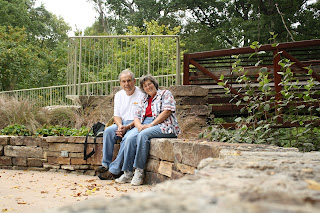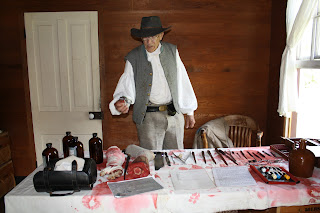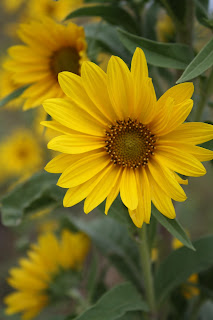A light mist dotted the windshield as we left Emporia, Kansas, for Carthage, Missouri. The sun burned through momentarily by the time we drove through Olpe, only about ten miles.
 |
The rail still stands as evidence
of soldiers' punishment for infractions of rules. |
"We'll be on country roads all day," said Andy, "and that's more of the sun than I thought we'd see today, even though the high was a predicted 76 degrees." Stalks of Maximillian sunflowers and bright yellow Compass Plant flowers lined the roadside, adding even more color to the fields of yellow goldenrod and maturing soy beans. Autumn was in the air, in spite of warm temperatures, but trees showed little sign of changing color. I attributed the brown, yellow and gold of the fields to dryness; yesterday's rain with this morning's fog provided only stopgap alleviation.
By the time we had driven to Fort Scott, billowing grey clouds came and went, and temperatures reached near 80 degrees.
 |
The Quartermaster's store held
supplies for life on the frontier. |
Fort Scott, both a fort and a town, was established in 1842, as one in a line of protective forts from Minnesota to Louisiana to enforce "the promise of a permanent Indian frontier." Named for General Winfield Scott, the fort housed infantry and dragoons, elite troops of soldiers trained to fight both on foot and on horseback. These dragoons escorted pioneers south and west along the Santa Fe Trail in 1843 and parleyed with Indian tribes who threatened pioneers on the Oregon Trail in 1844.
Captain Thomas Swords designed the construction and organized the building of the fort. Carefully overseeing all phrases of development, he ordered it to be "the crack fort of the frontier."
"That's probably why it's in such good condition today, " I told Andy.
Almost all the infantry and dragoons were ordered south to fight in the Mexican-American War of 1846-1848. Those few left behind continued a schedule of building construction and maintenance.
With Manifest Destiny of the late 1840's, the idea that America had the divine right to expand from coast to coast, and with the winning of the war against Mexico, the frontier expanded westward and the idea of "a permanent Indian frontier" died a quick death. Fort Scott had outlived its usefulness, so the army abandoned the location in 1853.
 |
Officers' quarters offer privacy for families in the backyards
with gardens, patios, shaded walkways and porches. |
Up to that time, the biggest problem for soldiers at Fort Scott was boredom. "That would account for the alcoholism," I told Andy. The sign in the hospital said that soldiers suffered from "malarious fever, diarrhea and alcoholism." In the winter pneumonia was a problem, and the disease was usually fatal.
Every soldier served in the bake ovens on rotating assignment. But fresh bread was not the reward. Officers believed stale bread aided digestion, so bread sat two days on open racks before it was served, unless soldiers toasted the fresh loaves.
Infractions of all rules were strictly punished: sitting in the stocks, sitting on a rail about eight feet off the ground, carrying a log, standing for hours on a barrel, sitting in jail or remaining in solitary confinement.
A barn houses a six-pound field artillery piece and two 12-pound Mountain Howitzers, examples of weapons pulled across country for attack or defense.
After 1853, the buildings were auctioned and Fort Scott became a town, the center of westward expansion. When the Kansas-Nebraska Act of 1854 legalized the two territories for settlement, Fort Scott offered the gateway west. As the town grew as a supply center, so too did the controversy about slavery. The result was "Bleeding Kansas," an era when violence, destruction and psychological warfare prevailed in the region.
 |
| In the bake ovens, every soldier took a turn at baking bread |
Andy and I stood on the green, once a military parade ground and then a town's grassy courtyard. To our left was the former officers' quarters, which by 1855 was the Fort Scott Hotel, nicknamed "Free State Hotel." This was home to abolitionists, who wanted to rid Kansas and the nation of the "peculiar institution," and free-staters who didn't want slavery expanded beyond its 1855 boundaries. To our right was the infantry barracks, which by 1855 had become the Western Hotel, headquarters for pro-slavery men, sometimes called Border Ruffians. Only a grass courtyard separated them. No wonder it all led to blows by 1858! We read the history, a fascinating and different perspective from what we both had learned in school.
"This country did some pretty awful things," said Andy. "The Indians got screwed, and hundreds of Blacks were considered less than human."
By the time territorial strife had waned in 1859, nearly 60 had died and hundreds lived in terror throughout Kansas, because of the struggle over slavery. Kansas entered the Union as a free state on January 29, 1861. That brought the Army back to Fort Scott.
We tried to imagine what life here must have been like--a major supply depot for the Union armies of the West, a general hospital for the entire region, a gathering haven for those fleeing from war, like displaced Indians, escaped slaves, widows and children, homeless farmers. The lovely, quiet green where we stood must have been a scene of misery and suffering as it teemed with activity and life.
Confederates targeted Fort Scott's military stores and tried twice unsuccessfully to capture the fort during the war. Here too one of the first African American regiments engaged the Confederates in combat.
We read all the historical displays, saw the 20-minute film and checked out each building. Even after 1865, when the war ended, Fort Scott played a role in the nation's development. When the first railroad reached the area in 1869, squatters forcefully opposed the laying of more tracks south of the city. The Army returned from 1869 to 1873 to protect railroad workers and defend big business from American citizens. Funny how that argument continues in 2012!
On a parallel note, economics drove interests in the 1860's. People saw slaves as property to be defended. A 16-year old slave girl in 1857 sold for 50 ounces of gold, or about $1000. That value in 2012 is $93,500. The total market value of slaves in 1860 was $4,000,000,000.00, which equates to $238,000,000,000.00 today. In 1860 about four million, or one out of every eight people, were enslaved. And not just slave owners cared about the economics. "One half of the richest Americans in 1860 lived in the South. Owning slaves had been their fast track to greater wealth. Yet only 25 percent of all Southern families had slaves. Even poor white Southerners with no slaves were for slavery--reassured by seeing a class of workers whom they thought would always stay below them."
It sure sounded to me like Huckleberry Finn and his dad Pap.
 |
This frame marks the foundation of the slave cabin where
George Washington Carver was born. |
"It's so early and the weather is holding," said Andy. "Look at the map and direct me south to the George Washington Carver National Monument."
Along the way past rural homes, Andy said, "It amazes me how many dirt roads still exist in Kansas and Missouri." Some of them showed evidence of grinding poverty. "I can't believe people really live like this."
I shook my head; I totally agreed.
Carver, who became a symbol of interracial cooperation, died at Tuskegee Institute on January 5, 1943. That same year the federal government designated his birthplace in Diamond, Missouri, as a national monument, the first park in the country to honor an African American scientist, educator and humanitarian. The interactive museum was amazing, a showplace for children and adults to experiment and learn in honor of a scientist who believed "it was simply service that measures success."
Carver, credited with transforming peanuts into products such as ink, paper, soap, glue, dyes, massage oil, milk and cosmetics, was motivated by his love for all creation. The literature said, "For him, every life was a window on God and a mouthpiece through which the Great Creator spoke. He saw all living things as interrelated."
We walked the mile-long trail past the spot where he had probably been born, the site of an 8x8-foot shed that was wiped out by a tornado; along the pond where he learned to appreciate nature; through the house where owners Moses and Susan Carver lived; past the cemetery where the farm family is buried; and back to the museum.
 |
In the woods the boy statue of George
Washington Carver overlooks
the land where he roamed and learned. |
Carver's story was a fascinating one. A butterfly landed on Andy's shoulder. It was a Great Spangled Fritillary. Not far away a Buckeye butterfly fluttered over the sun flowers. We read the Carver inscriptions along the path: "You are the handicap you must face." and "Education is the key to unlock the golden door of freedom to our people." George Washington Carver was a "father" and innovator in his own way.
George was born around 1864 to Mary, a 13-year old slave purchased by Moses Carver for $700. Her second son, he was caught up in the guerrilla warfare of the Civil War on the Missouri-Kansas border when he and his mother were kidnapped. Moses Carver sent a man to find his stolen slaves, but only George was returned from Arkansas, orphaned and almost dead from whooping cough. He remained in frail health for years, which freed him from many chores around the farm and gave him time to explore in the woods. The Carvers raised George and his older brother Jim. In his autobiography, Carver wrote, "From a child I had an inordinate desire for knowledge, and especially music, painting, flowers and the sciences." He created a little garden hidden in brush not far from the house. Here, unbeknown to anyone, he nurtured plants that thrived under his touch. Later as a child he would be known as The Plant Doctor, and plants from all over the country would be brought to him for treatment.
 |
Carver's voice from this
statue explains the values
he learned on the Carver farm,. |
No colored schools were available near Diamond, so the Carvers permitted George to attend school in Neosho, eight miles away. He cooked for a wealthy family in Fort Scott, Kansas, to earn board, clothes and school privileges. A lynching of a black man in Fort Scott in 1879 so moved Carver that he left the town for good. Eventually earning a high school diploma with background in Latin and Greek, he entered business college in Kansas City, was admitted to Highland College and then refused for racial reasons, and finally earned acceptance to Simpson College in Iowa for art. The only African American at the school, his acceptance could be credited to the display of his painting
Yucca and Cactus at the World's Fair. He opened a laundry to support himself and lived on prayer, beef suet and corn meal.
Transferring to Iowa State Agricultural College in 1891, he pursued agriculture and earned two degrees by 1896. That year Carver accepted an offer from Booker T. Washington to head the new Agriculture Department at Tuskegee Institute in Alabama.
 |
Unusual art decorates a
gas station near Carthage. |
The post was his dream job "to do the greatest good to the greatest number of my people." Here he was able to develop the peanut, a crop that would free African American farmers from the tyranny of "King Cotton," which had destroyed the soil in the South. He also wrote 43 educational bulletins for average farmers, several of which were distributed throughout the world.
Inside the museum I learned about the Short Course. Carver developed a two-week class in agriculture at Tuskegee Institute, a series of practical lessons for ambitious, young farmers. It featured free admission, affordable accommodations, and classes in the winter when farmers could attend. In 1904, he attracted 20 students; by 1912, there were 1500 enrolled. Carver understood the needs of the average person, and fame never changed this humble servant of the people.
 |
Surrounded by one-story stores, the Carthage Courthouse
on the village green, looks like a medieval castle. |
We headed toward Carthage, Missouri, for the night... couldn't find the White Rose Winery but enjoyed some unusual art along the way. And the Courthouse at Carthage stood out in the frontier environment.
We had had a moving and inspiring day, and, ironically, the two unrelated self-guided tours were intimately related after all.























































